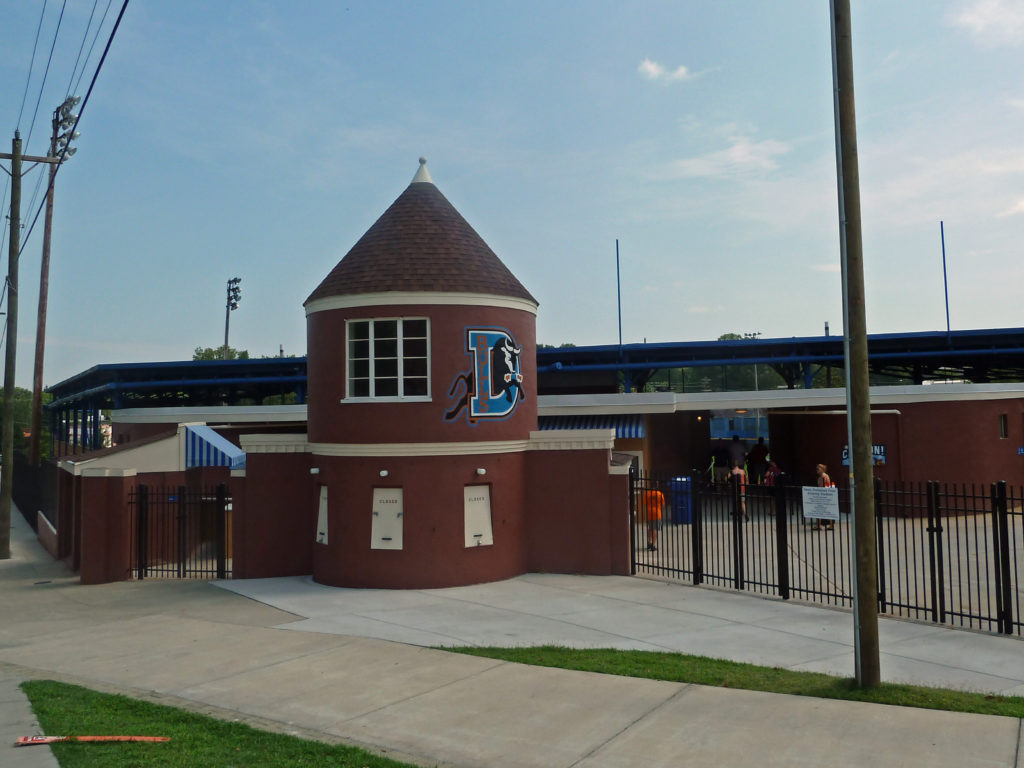In the 30 years since it was released, Bull Durham has cemented its place among the most recognizable and beloved baseball movies. The film—starring Kevin Costner, Susan Sarandon, and Tim Robbins—has been credited for its entertaining and accurate portrayal of Minor League Baseball through a fictionalized Durham Bulls team, allowing it to resonate decades after its 1988 release.
Bull Durham was first released on June 15, 1988. In honor of its 30th anniversary, we are offering a homage to Bull Durham that celebrates its settings—several ballparks around baseball. What follows is a rundown of the ballparks featured in the production of Bull Durham, and what has come of them since the film’s release.
Durham Athletic Park
The primary setting for the film, Durham Athletic Park managed to create its own historical significance as a decades-long home of professional baseball. That—combined with its role in Bull Durham—has contributed to its appeal in the years since the Bulls departed for a new ballpark. Durham Athletic Park, which still looks very similar to how it appeared in the film, still stands today and is used for a variety of events. In fact, the Bulls hosted a special screening of Bull Durham on June 8 to honor its anniversary.
Fleming Stadium
One of the most memorable scenes in the film is when Crash Davis (Costner) sets off the ballpark sprinklers to force a rainout. That scene was shot in Fleming Stadium, the historic ballpark in Wilson, NC. Fleming Stadium is currently the home of the Wilson Tobs (summer collegiate; Coastal Plain League) and has received several renovations over the years.
World War Memorial Stadium (Greensboro)
The departure of the Greensboro Bats (Low A; Sally League) following the 2004 season marked the end of professional baseball for this historic ballpark. While the move of the Bats (now the Grasshoppers) to a new downtown ballpark prompted plenty of questions about its future, War Memorial Stadium remains standing today for college baseball.
McCormick Field
When Crash sets a new minor league home run record at the end of the film, he does so as a member of the Asheville Tourists. That scene takes place at McCormick Field, a long-time site for professional baseball in Asheville. Still home to the Tourists (Low A; Sally League) the ballpark’s appearance is different today than it was in Bull Durham, due largely to a reconstruction project that was completed prior to the 1992 season.
Burlington Athletic Stadium
Burlington Athletic Stadium can be credited with an appearance during a road trip sequence in the film. It remains an active MiLB facility, as it is currently the home of the Burlington Royals (Rookie; Appalachian League).
Arlington Stadium
The lone major league ballpark to appear in Bull Durham no longer stands. In one of the final scenes of the film, “Nuke” LaLoosh (Robbins) is being interviewed on the field as a major league pitcher. That was shot in Arlington Stadium, the home of the Texas Rangers from 1972-1993. The Rangers moved into The Ballpark in Arlington (now Globe Life Park in Arlington) in 1994, and Arlington Stadium was promptly demolished.
Photo by Zach Spedden.
Want inside information on the making of Bull Durham, including an interview with Miles Wolff on the film? Check out Cradle of the Game, Mark Cryan’s book on North Carolina ballparks past and present. You’ll learn how Bull Durham came to be, how the iconic Bulls logo was created and why Pete Bock appears in the film.
This article first appeared in the Ballpark Digest newsletter. Are you a subscriber? It’s free, and you’ll see features like this before they appear on the Web. Go here to subscribe to the Ballpark Digest newsletter.

